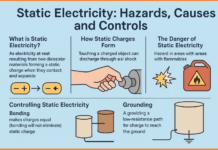In then hazardous environment of oil and gas plants, safety remains a topmost priority. The effective management of emergencies and the swift response to potential threats are critical aspects of ensuring the safety of workers of and the protection of valuable assets. One integral component that plays a major role in emergency response systems within these plants is the Manual Call Point (MCP).
Contents
What is Manual Call Point (MCP)
Manual Call Point, often referred to as emergency break glass unit or fire alarm call point, is device designed to allow individual to manually initiate an alarm in the event of an emergency. In the context of oil and gas plant, these devices serve as an immediate means for workers to communicate potential risks, such as fires, gas leaks, or other hazardous situations.
Key Features of MCPs in Oil & Gas Plants
- Quick Activation: MCP is strategically located throughout the plant in easily accessible areas. Their conspicuous design, often featuring a breakable glass cover, allows personnel to swiftly activate the alarm by breaking the glass and pushing the button beneath it. This ensures that response actions can be initiated promptly, minimizing the impact of the emergency.
- Integration with Fire and Gas Detection Systems: Modern MCP are seamlessly integrated with advanced fire and gas detection systems present in oil and gas plants. This integration enables the automatic activation of alarms when the detection systems identify potential threats, providing an additional layer of safety.
- Robust Construction: Considering the challenging environmental conditions in oil and gas facilities, MCP are constructed with durability in mind. They are often designed to withstand harsh weather conditions, extreme temperatures, and corrosive environments, ensuring reliability when needed the most.
- Indication and Feedback: Once activated, MCP provide clear visual and auditory indications to alert nearby personnel of the emergency. Additionally, feedback mechanisms are incorporated to confirm the successful transmission of the alarm signal to the central control room, ensuring that response teams are aware of the situation.
- Integration with Emergency Response Plans: Manual Call Point is integral component of the overall emergency response plan of oil and gas plants. They are part of a comprehensive safety network that includes communication systems, evacuation procedures, and emergency response teams, contributing to a well-coordinated and efficient response to emergencies.
Benefits of MCP in Oil & Gas Plant
- Rapid Response: The manual activation feature of MCP allows for immediate response in the early stages of an emergency, preventing the escalation of the situation.
- Minimized Downtime: Swift identification and containment of emergencies through MCP contribute to minimizing downtime by preventing extensive damage to equipment and infrastructure.
- Enhanced Personnel Safety: By empowering personnel to take immediate action, MCP contribute to the overall safety culture of the plant, ensuring that workers are actively engaged in maintaining a secure working environment.
- Compliance with Regulatory Standards: Oil and gas plants are subject to stringent safety regulations. The installation and proper functioning of MCP contribute to compliance with these standards, helping the facility avoid legal and financial repercussions.
In the intricate and high-risk environment of oil and gas plants, the significance of Manual Call Point cannot be overstated. These devices serve as the first line of defense, enabling rapid response to emergencies and facilitating the protection of both personnel and assets. The continuous evolution of technology ensures that MCP remain at the forefront of safety systems, providing oil and gas facilities with reliable tools to mitigate risks and enhance overall operational safety. As the industry progresses, the integration of cutting-edge technologies with Manual Call Point will further contribute to the resilience and efficiency of emergency response systems in these critical facilities.
Frequently Asked Questions for Manual Call Point (MCP)
Q: What is a Manual Call Point (MCP)?
A: A Manual Call Point (MCP) is a device designed for emergency situations to manually initiate an alarm, typically in fire detection and alarm systems. It allows individuals to activate the alarm by breaking a glass or pushing a button, signaling the need for immediate attention.
Q: Where are Manual Call Points commonly used?
A: Manual Call Points are commonly used in buildings, facilities, and public spaces where fire detection and alarm systems are installed. They are strategically located along escape routes, near exits, and in areas where people are likely to notice and access them easily.
Q: How does a Manual Call Point work?
A: In the event of an emergency or when a person observes a fire or other hazard, they can manually activate the alarm by breaking the glass or pressing the button on the MCP. This action sends a signal to the fire alarm control panel, triggering the alarm and alerting occupants and emergency responders.
Q: Are Manual Call Points only used for fire emergencies?
A: While Manual Call Points are commonly associated with fire alarm systems, they can be used in other emergency situations as well. Some systems may integrate MCPs for various emergencies, allowing individuals to initiate alarms for events such as gas leaks or security threats.
Q: What are the key components of a Manual Call Point?
A: A typical Manual Call Point consists of a breakable glass or a resettable element (depending on the design), a reset mechanism, and a button or lever for manual activation. The device is connected to the fire alarm control panel through wiring.
Q: How should Manual Call Points be maintained?
A: Regular maintenance is crucial to ensure the reliability of Manual Call Points. This includes checking for physical damage, ensuring the glass or resettable element is intact, and verifying the electrical connections. Routine testing and inspections are recommended to confirm that the MCPs are operational.
Q: Are there different types of Manual Call Points?
A: Yes, there are various types of Manual Call Points designed to meet specific needs. These may include addressable or conventional MCPs, weatherproof or vandal-resistant models, and options with additional features like LED indicators or sounders for visual and audible alerts.
Q: Can Manual Call Points be reset after activation?
A: In most cases, Manual Call Points can be reset after activation. However, this process typically requires a designated key or tool to reset the device and return it to normal operating conditions. This ensures that the system is ready for future activations.
Q: How do Manual Call Points contribute to overall safety?
A: Manual Call Points play a crucial role in enhancing safety by allowing for quick and manual initiation of alarms. This rapid response helps ensure that occupants are alerted promptly to emergency situations, facilitating a swift and orderly evacuation or response by emergency services.





